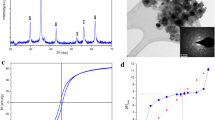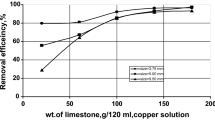Abstract
Kinetics of the 2,4,6-trinitrophenol reaction with iron powder was investigated voltammetrically. The process was found to be mainly governed both by the iron powder characteristics and by the solution composition. Degradation kinetics was generally represented by a pseudo-first-order rate law. Consecutively, the 2,4,6-trinitrophenol reduction reaction rates for three fractions of iron powder as well as the effect of individual ions presented in the reaction system were evaluated. A correlation between the reaction rate and both the grain size of iron particles and the state of their surface was found. The effect of the reaction system composition was investigated for two types of buffered medium: Britton-Robinson buffer (boric acid, orthophosphoric acid, and glacial acetic acid) and acetate buffer solution (sodium acetate and acetic acid).
Similar content being viewed by others
References
Agrawal, A., & Tratnyek, P. G. (1996). Reduction of nitro aromatic compounds by zero-valent iron metal. Environmental Science & Technology, 30, 153–160. DOI: 10.1021/es950211h.
Choi, J. H., Kim, Y. H., & Choi, S. J. (2007). Reductive dechlorination and biodegradation of 2,4,6-trichlorophenol using sequential permeable reactive barriers: Laboratory studies. Chemosphere, 67, 1551–1557. DOI: 10.1016/j.chemosphere.2006.12.029.
Gálová, M., Oriňáková, R., & Lux, L. (1998). Distribution of charge in the process of coating Fe powder by electrolysis in a fluidized bed. Journal of Solid State Electrochemistry, 2, 2–6. DOI: 10.1007/s100080050057.
Gotpagar, J. K., Grulke, E. A., & Bhattacharyya, D. (1998). Reductive dehalogenation of trichloroethylene: kinetic models and experimental verification. Journal of Hazardous Materials, 62, 243–264. DOI: 10.1016/S0304-3894(98)00184-8.
Heiss, G., & Knackmuss, H.-J. (2002). Bio-elimination of trinitroaromatic compounds: immobilization versus mineralization. Current Opinion in Microbiology, 5, 282–287. DOI: 10.1016/S1369-5274(02)00316-8.
Heželová, M., Pikna, L’., Kladeková, D., & Lux, L. (2006). Effect of chloride ions on the kinetics of nitrobenzene reduction by powdered iron. Chemical Papers, 60, 360–364. DOI: 10.2478/s11696-006-0065-1.
Hofmann, K. W., Knackmuss, H.-J., & Heiss, G. (2004). Nitrite elimination and hydrolytic ring cleavage in 2,4,6-trinitrophenol (Picric acid) degradation. Applied and Environmental Microbiology, 70, 2854–2860. DOI: 10.1128/AEM.70.5.2854-2860.2004.
Kladeková, D., Heželová, M., & Lux, L. (2007). Evaluation of surface reactivity of Fe powders: Reaction with nitrobenzene. Particulate Science and Technology, 25, 139–146. DOI: 10.1080/02726350701257857.
Lavine, B. K., Auslander, G., & Ritter, J. (2001). Polarographic studies of zero valent iron as a reductant for remediation of nitroaromatics in the environment. Microchemical Journal, 70, 69–83. DOI: 10.1016/S0026-265X(01)00075-3.
Lux, L., Gálová, M., Heželová, M., & Markušová, K. (1999). Investigation of the reactivity of powder surface by abrasive voltammetry. Journal of Solid State Electrochemistry, 3, 288–292. DOI: 10.1007/s100080050159.
Mockovčiaková, A., Ficeriová, A., Boldižárová, E., & Kmecová, E. (2003). Fractal surface and kinetics of leaching process of mechanically activated sulfitic mineral. In Proceedings of the 4th International Conference on Particulate Compounds in Science, Industry, and Environment, 11–12 November 2003 (pp. 71–74). Košice, Slovakia: Technical University in Košice (in Slovak).
Nord, H., & Bech-Nielsen, G. (1971). The anodic dissolution of iron-III. Coverage on iron in the active and passive states in acid carboxylate solutions. Electrochimica Acta, 16, 849–864. DOI: 10.1016/0013-4686(71)85052-1.
Ramos, J. L., González-Pérez, M. M., Caballero, A., & van Dillewijn, P. (2005). Bioremediation of polynitrated aromatic compounds: plants and microbes put up a fight. Current Opinion in Biotechnology, 16, 275–281. DOI: 10.1016/j.copbio.2005.03.010.
Scherer, M. M., Johnson, K. M., Westall, J. C., & Tratnyek, P. G. (2001). Mass transport effects on the kinetics of nitrobenzene reduction by iron metal. Environmental Science Technology, 35, 2804–2811. DOI: 10.1021/es0016856.
Author information
Authors and Affiliations
Corresponding author
Rights and permissions
About this article
Cite this article
Kladeková, D., Heželová, M. Influence of solution composition and iron powder characteristics on reduction of 2,4,6-trinitrophenol. Chem. Pap. 62, 553–558 (2008). https://doi.org/10.2478/s11696-008-0075-2
Received:
Revised:
Accepted:
Published:
Issue Date:
DOI: https://doi.org/10.2478/s11696-008-0075-2




